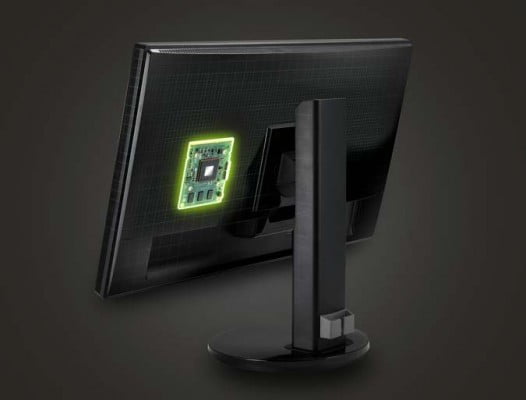
Nvidia is the most well-known name in graphics cards, but the company has also become synonymous with something else: G-Sync. Launched back in 2013, G-Sync is a piece of Nvidia tech housed in certain computer monitors and gaming laptops to increase their performance, with a focus on reducing input lag and eliminating screen tearing.
If you’re in the market for a new PC monitor or a G-Sync gaming laptop, you’ll want to know the benefits of G-Sync — as well as how it compares to AMD’s FreeSync alternative.
Contents
What is screen tearing?
One of biggest benefits of a G-Sync monitor or laptop display is its ability to resolve an issue known as screen tearing. In certain cases, the video signal from the graphics card will output to the monitor at a rate the display is not capable of handling, which results in a horizontal line or “tear” across the screen.
Traditionally, this is helped by enabling V-Sync within a game’s settings menu to throttle the output from the graphics card to match the monitor and avoid screen tearing. However, enabling V-Sync can introduce input lag and put a greater strain on your graphics card, which in turn, can affect overall performance during gameplay.
How is G-Sync better than V-Sync?
While V-Sync makes the graphics card change its output to work better with your monitor, G-Sync works by directly controlling the display to handle the video signal from the graphics card. This eliminates the drawbacks of V-Sync while still avoiding screen tearing.
Because monitors have a fixed refresh period and graphics cards have inconsistent output based on the image they’re rendering, problems arise when graphics cards output too quickly or too slowly to the monitor. G-Sync changes the monitor’s refresh rate so that it works best with what the graphics card is delivering, including making real-time predictions of the graphics card output based on recent performance.
What are the best laptops with G-Sync support?
Nvidia brought G-Sync support to gaming laptops in 2015, delivering all of the benefits of a G-Sync monitor to a laptop display. Interestingly, Nvidia makes use of its G-Sync tech without relying on the same chip needed in stand-alone PC monitors, instead making use of the graphics card to control output and avoid screen tears or input lag.
MORE: The Best Gaming Laptops
The Alienware 17 R4 comes in two G-Sync configurations, currently starting at $2,199, and compares well to high-end PC gaming rigs. The base G-Sync model comes equipped with a GTX 1070 and an Intel i7-7700, but those can be bumped up to a GTX 1080 and an i7-7820 for $2,499. Either model is more than enough to tackle new releases at the display’s 1440p resolution with full G-Sync support.

But if you’re looking for a no-compromise portable gaming machine, the Origin PC Eon17-SLX 10 Series for the princely sum of $4,708 will get you there (and back again). Stocked with a 4K G-Sync display and two GTX 1080s, this would hard to beat for any gaming setup, be it a console, laptop or desktop gaming PC.
What are some good G-Sync monitors?
Among our top picks for PC monitors over at sister site Tom’s Guide, we reviewed three G-Sync displays worth considering.
The Dell 24 S2417DG comes in at a remarkably low $469 for a 1440p, 24-inch screen with G-Sync support. But you can go further up the scale with the $1,290 Acer Predator X34, a 34-inch, 1440p, curved display designed to fill your field of view.

If you’re looking for a 4K G-Sync experience, the Acer Predator XB321HK is our pick. This 32-inch display lists for $1,399 and represents a high end for gaming monitors, coming equipped with onboard software extras and strong built-in speakers.
How does G-Sync differ from FreeSync?
Nvidia’s G-Sync and AMD’s FreeSync accomplish a lot of the same things, just through different methods. Both of them combat screen tearing by employing “adaptive sync” technology to avoid the input lag of traditional V-Sync. However, G-Sync does hold an edge when working with low frame rates that can arise during graphically intense moments.
Lower frame rates will cause a FreeSync monitor to fall back on traditional V-Sync methods, which brings back the old issues of either input lag or screen tearing if you choose to disable V-Sync. A G-Sync monitor doesn’t make the same use of V-Sync, instead handling low frame rate issues on its own.
[Source:- Laptopmag]










